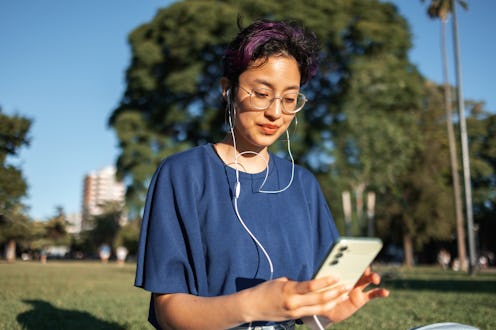Wellness
“Brain Flossing” Will Help You Chill Out In Minutes
“Why did this make me start crying? Pure relief.”

Flossing your teeth leaves your mouth feeling clean and refreshed, so imagine how good it would feel if you could do the same thing to your brain. Even though you can’t literally get in there with dental floss (bummer) you can create a similar effect with “bilateral stimulation” music — a trend that’s going viral on TikTok that’s said to help improve anxiety, stress, and focus.
Also called “brain flossing” or “brain massage,” bilateral stimulation is a type of sound that bounces between your right and left ears. It creates a panning effect that makes it seem like the tune is gliding from one side of your brain to the other, kind of like floss. For a good example, check out this link from TikTok creator @flaircontentbyamber.
If you have anxiety, ruminating thoughts, or distracting symptoms of ADHD, then you might experience an immediate sense of calm while listening to bilateral music — and that’s all part of its appeal. Under @flaircontentbyamber’s video, one person said, “Why did this make me start crying? Pure relief.” Another wrote, “It quiets my ADHD and lets me focus.”
Creator @living.withadhd also posted a bilateral song, and it’s since gained nearly 500,000 likes. “I can literally feel it moving from one side of my brain to the other,” one person wrote in the comments. Another said, “This is the first time I’ve felt that flossing/pulling/tingling feeling in my frontal lobes. Weird but nice.” Here’s what to know about brain flossing, according to an expert.
Why Does “Brain Flossing” Feel So Good?
According to Dr. Caroline Fenkel, LCSW, a therapist and chief clinical officer at Charlie Health, bilateral music is designed to engage both the right and left hemispheres of your brain in a specific pattern that promotes relaxation, focus, and even emotional processing.
“The rhythmic left-right stimulation helps calm the nervous system, similar to how bilateral stimulation is used in therapies like EMDR [eye movement desensitization and reprocessing],” she tells Bustle. “It supports emotional processing [...] making it easier to work through feelings without being overwhelmed.”
That’s why this type of music could lead to an emotional release, like a big sigh or a sob sesh, but it can also feel soothing when you’re stressed. As Fenkel says, it helps you feel relaxed because it quiets racing thoughts, and that’s why it can also prep your brain for rest. The bouncy nature of the music helps block out that incessant, internal chatter that might keep you up at night.
Some say this type of music immediately quiets their mind in a way they never thought possible, “similar to the effects of meditation or deep breathing,” says Fenkel. “Some research suggests it may also influence brainwave activity, shifting the brain into a calmer state.”
The Best Times To Brain Floss
If you’re in the mood to chill, pull up a bilateral song on TikTok or YouTube. While it’s best to listen with headphones, you can also hold your phone horizontally in front of you to get the same effect as the track bounces between your phone’s speakers.
You can listen anytime, anywhere, even if you don’t have anxiety or ADHD. “Anyone can listen to bilateral music,” says Fenkel. “It’s a simple, non-invasive tool that can support focus, relaxation, and emotional regulation.”
Try it while traveling to soothe anxiety, while studying to block out annoying noises, or before bed when you want to keep your brain nice and quiet so you can quickly nod off. “Some people also use it during meditation or mindfulness practices to deepen relaxation,” she says. Simply kick back, listen, and let our brain get flossed.
Studies referenced:
Amano, T. (2016). The Role of Alternating Bilateral Stimulation in Establishing Positive Cognition in EMDR Therapy: A Multi-Channel Near-Infrared Spectroscopy Study. PLoS One. doi: 10.1371/journal.pone.0162735.
Source:
Dr. Caroline Fenkel, LCSW, therapist, chief clinical officer at Charlie Health